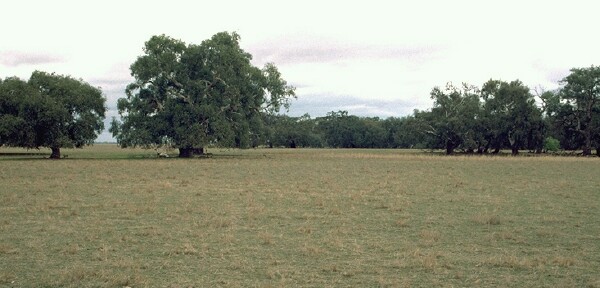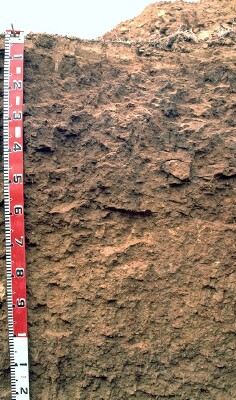LP117
| Group: Bendigo Creek Floodplain Group | Australian Soil Classification: Vertic (and Calcic), Mesonatric, Brown SODOSOL |
| Northcote Factual Key: Db 1.13 | Great Soil Group: red-brown earth |
| General Landscape Description: Level plain. | Geology: Alluvial deposits (Quaternary). Coonambidgal Formation. |
 LP117 Landscape |
Soil Profile Morphology
Surface Soil
| A1 | 0-8 cm | Dark yellowish brown (10YR4/4), sandy clay loam; weak blocky structure; very firm consistence when dry; pH 6.4; abrupt change to: |  LP117 Profile |
| A3 | 8-15 cm | Dark yellowish brown (10YR3/4), heavy sandy clay loam; strong consistence when moderately moist; pH 6.8; abrupt change to: | |
| Subsoil | |||
| B21 | 15-35 cm | Dark brown (10YR3/3), medium heavy clay; weak very coarse blocky structure, breaking to strong coarse blocky structure; firm consistence when moist; slickensides evident from 30 cm down; pH 7.6; gradual change to: | |
| B22 | 35-70 cm | Yellowish brown (10YR5/6), medium clay; strong coarse blocky structure, breaking to moderate medium sized polyhedral structure; firm consistence when moist; very few (>1%) hard carbonate nodules; pH 8.6; clear and wavy change to: | |
| B23 | 70-100 cm | Yellowish brown (10YR5/8), medium clay; weak coarse polyhedral structure, breaking to strong medium sized polyhedral structure; weak consistence when moist; few soft and hard carbonates (5%); pH 8.5; clear and wavy change to: | |
| B24 | 100-120 cm | Dark yellowish brown (10YR4/4), medium clay; moderate coarse prismatic structure, breaking to strong medium sized polyhedral structure; up to 10% manganese stains in the upper part of this horizon; pH 8.6. | |
Key Profile Features
- Strong texture contrast between surface (A) horizons and subsoil (B) horizons.
- Vertic properties (slickensides) throughout the subsoil.
Key Profile Characteristics
pH | Salinity Rating | |||
Surface (A1 horizon) | slightly acid | very low | sodic | moderate |
Subsoil (B21 horizon) | slightly alkaline | very low | strongly sodic | complete |
Deeper subsoil (at 100+ cm) | strongly alkaline | low - medium | sodic | slight |
 |
Management Considerations:
Whole Profile
- The entire profile is sodic and dispersive which will result in restricted root and water movement in the soil. Water is likely to build up on the surface and in the surface horizons (as they are more porous) after heavy rains causing waterlogging and surface runoff. The addition of gypsum may ameliorate this problem. A test strip could be used to assess the likely benefits.
Surface (A) Horizons
- The surface being dispersive will be affected by disturbance (ie cultivation, overstocking) in a moist condition and may even be affected by the action of rain on the surface of the soil. These actions may exacerbate the hardsetting condition of the soil. This may result in surface sealing which will reduce water infiltration and seedling emergence.
- Organic carbon levels show that organic matter content is low for the surface soil from this pit. Organic matter is important for enhancing soil aggregation, fertility and water holding capacity. Organic matter levels will build up under pasture but will decline if cultivation takes place. Practices such as residue retention, minimum tillage and including pasture rotations should be utilised if cropping occurs.
- The surface horizons have a low inherent fertility (based on the sum of the basic exchangeable cations).
Subsoil (B) Horizons
- The subsoil displays vertic properties (ie. slickensides) which indicates that significant shrinking and swelling occurs in the deeper subsoil. This may have implications for engineering purposes (eg. disturbance to fencelines).
- The deeper subsoil (from 35 cm depth) is strongly alkaline which indicates that some nutrients (eg. copper, iron, manganese, and zinc) may be poorly available to deeper rooted plants.
- Deep subsoil (below 70 cm) is slightly saline.
Comments from Landholder:
- Waterlogging a problem in this paddock.
- Floods every 2-3 years.
- Agisted cattle caused pugging last year.
- Oats sown over subclover as standing feed.
Notes
- Profile described by Paul Rampant and Ruth Lourey (22/5/96)


